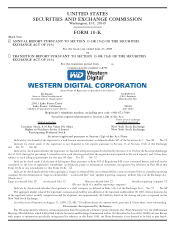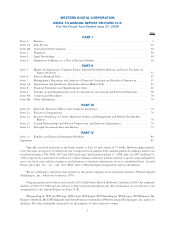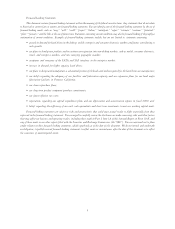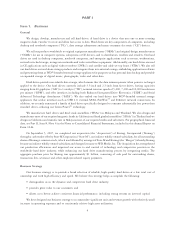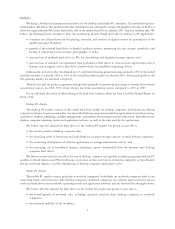Western Digital 2008 Annual Report Download - page 16
Download and view the complete annual report
Please find page 16 of the 2008 Western Digital annual report below. You can navigate through the pages in the report by either clicking on the pages listed below, or by using the keyword search tool below to find specific information within the annual report.logical track and sector locations. Guided by instructions from the controller, the HSA pivots in an arc, across the disk
until it reaches the selected track of a disk, where the data is recorded or retrieved.
Industry standard interfaces allow the hard drive to communicate with the computer. Currently, the primary
interfaces for PCs are EIDE and SATA, and the primary interfaces for enterprise systems are SCSI, SATA, SAS and FCAL.
As computer performance continues to improve, the hard drive will need to deliver information faster. We believe this
will continue to drive the PC industry transition to higher speed interfaces, such as SATA and SAS, to facilitate the higher
data transfer rates. We currently offer the SATA interface on our WD Caviar», WD Scorpio»,WD»RE, WD
VelociRaptor
TM
and WD»AV hard drive families; and EIDE on WD Caviar», WD Scorpio»and WD»AV families.
The number of disks and each disk’s areal density, which is a measure of the amount of data that can be stored on the
recording surface of the disk, determines storage capacity of the hard drive. The higher the areal density, the more
information can be stored on a single platter. Achieving a given drive capacity requires fewer disks and heads as the areal
density increases, potentially reducing product costs over time through reduced component requirements. Beginning in
June 2007, we began shipping 3.5-inch hard drives with 188 GB per platter areal density and 2.5-inch hard drives with
125 GB per platter areal density. In July 2007, we introduced the WD Caviar»GreenPower
TM
3.5-inch hard drive which
has 250 GB per platter areal density. In October 2007, we introduced WD Scorpio»2.5-inch drives that employ 160 GB
per platter technology. In January 2008, we began shipping a 3.5-inch hard drive platform with 320 GB per platter areal
density and in June 2008, we began shipping our WD Caviar»family of drives at 333 GB per platter areal density. In
April 2008, we began shipping WD VelociRaptor
TM
hard drives, 2.5-inch 300 GB drives employing the highest
shipping areal density in the industry at 290 gigabits per square inch.
Head technology is one of the key components affecting areal density. Historically, there have been rapid technological
changes resulting in several generations of head technology in a relatively short time. However, in recent years the time has
lengthened between changes in generations of head technology. The hard drive industry has essentially transitioned from the
use of longitudinal magnetic recording (“LMR”) head technology for the head writer function to perpendicular magnetic
recording (“PMR”) technology, which allows for significantly higher storage capacities. In addition, the industry has made the
transition to tunnel-junction magneto resistive (“TMR”) technology for the head reader function. We have completed the
transition to PMR and TMR in our 2.5-inch products and in the majority of our 3.5-inch products.
With the transition to PMR, media plays a much more important role in achieving higher areal density. PMR
demands a much tighter interaction and matching between head and media designs. The acquisition of Komag has
enabled us to be vertically integrated in the two most important technology components of hard drives (heads and
media), and has enabled us to achieve a more optimum design and utilization of these components.
We invest considerable resources in research and development, manufacturing infrastructure and capital equipment
of head and media components, in order to secure our competitive position and cost structure.
The WD»product line generally leverages a common platform for various products within product families with
different capacities to serve differing market needs. This platform strategy results in commonality of components across
different products within product families and, in some cases, across product families, which reduces exposure to changes
in demand, facilitates inventory management and allows us to achieve lower costs through purchasing economies. This
platform strategy also enables our customers to leverage their qualification efforts onto successive product models.
Fiscal 2008 represented the sixth consecutive year of substantial growth in our research and development and capital
spending to support our significant broadening of our product and technology portfolios. Over that six-year period, we have
grown our investment spending 173% from $170 million in fiscal 2002 to $464 million in fiscal 2008. As a result of this
investment activity, we continue to expand our business beyond the desktop PC market into newer markets or markets in
which we have not previously participated. Such investments have allowed us to execute against our strategic objective of
revenue diversification to address the growth of new applications for hard drives and fast-growing new market opportunities.
We are currently expanding our existing head wafer fabrication facilities in Fremont, California to accommodate our
anticipated growth. The expansion will involve a process change to utilize 8-inch wafers from 6-inch wafers and will cost
an estimated $280 million in the fiscal 2009 to 2010 timeframe. This will be in addition to our ongoing capital
expenditures for hard drive and head assembly, and our anticipated capital expenditures for media development and
manufacturing following our planned acquisition of Komag.
10



